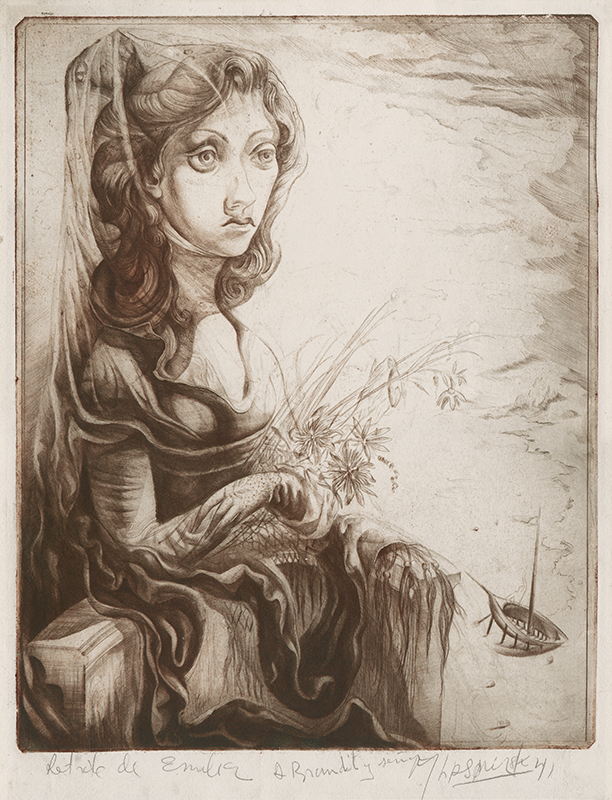
19th, 20th & 21st Century Fine Prints
707-546-7352 · fax 707-546-7924 · web: www.annexgalleries.com · email: artannex@aol.com
Retrato de Emilia by Mauricio Lasansky

Retrato de Emilia
Mauricio Lasansky
Retrato de Emilia
Mauricio Lasansky
1914 - 2012 (biography)This scarce Surreal portrait of Lasansky’s wife Emilia, (1917 - 2009) whom he had married in 1937. The plate was printed using a sepia/black ink. An unfinished boat with a suggested figure and the delicate “landscape” that stretches to infinity contrasts the intricate, dream-like state of the subject.
"Portrait of Emilia" was done in Argentina, in 1941, two years before Mauricio left for New York to work at Atelier 17. This impression is pencil dedicated "A Brandt y senor". A.M. Brandt was a colleague of Lasansky's at the Free Arts School in Villa Maria, Cordoba, Argentina.
Museum Director/ print scholar Alan Fern commented about these drypoints on page 12 of the University of Iowa's catalog "Lasansky: Printmaker": "The drypoints...are lyrical and imaginative, relying on surrealist juxtapositions of interior and exterior space, objects in different scale, and interpenetrations of one form by another. These early works are consciously poetic; many of Lasansky's friends and intellectual heroes were poets and writers, who used language in the Spanish tradition with a rich employment of metaphors, strange juxtapositions of objects and ideas, and the frequent expression of states of mind in similes - equivalents for feelings being made vivid by references to objects." Maurico Lasansky was one of the few modern artists who worked almost exclusively in the graphic media.
Born in Buenos Aires, Argentina on October 12, 1914, to an Eastern European immigrant who worked as an engraver of bank notes, Lasansky began attending the Superior School of Fine Arts in 1933. His background was partially responsible for his interest in printmaking and he began his career by making woodcuts. He later turned to intaglio, concentrating on drypoint, and his first solo exhibition was presented in 1935 at Fort General Roca, Argentina.
In 1936, at the age of twenty-two, Lasansky had already become the director of the Free Fine Arts School in Villa Maria, Cordoba, Argentina. Francis Henry Taylor, director of the Metropolitan Museum of Art, met Lasansky in Argentina in 1941 and was so impressed with his work that, in 1943, he arranged for Lasansky to travel to New York on a Guggenheim Fellowship. Shortly after his arrival, he sent for his wife and children, as “he didn’t want to go back to Peron.” Lasansky studied the entire print collection of the Metropolitan Museum of Art and worked at Hayter’s experimental workshop, Atelier 17.
Invited by Professor Lester Longman to join the faculty of the University of Iowa, Lasansky relocated to Iowa City in 1946. He swiftly renovated the university’s printmaking department which had previously been directed by Emil Ganso who had died of a heart attack at age 46. Within two years he was named associate professor of art and the Iowa Print Group was formed under his leadership. In January 1949, an exhibition of the members’ prints, entitled A New Direction in Intaglio, was installed at the Walker Art Center in Minneapolis. Lasansky made Iowa a germinal school and his students, including Ernest Freed, Malcolm Myers, John Paul Jones, Lee Chesney, Glen Alps, Ray French, and James Steg, carried on his principles as printmakers running graphic arts departments everywhere from U.C.L.A. to the universities of Texas, Minnesota, Kansas and Illinois, as well as Tulane, Michigan State and the Cleveland Institute of Art.
Lasansky was made a full professor of art in 1948 and by 1952 he had an impressive exhibition history as well as American citizenship. In 1957, an important retrospective exhibition of his prints was mounted at the Univeristy of Iowa, and in 1960 the Ford Foundation sponsored a retrospective exhibition of his work that was accompanied by a catalogue written by Carl Zigrosser.


